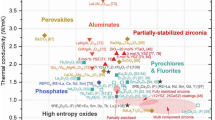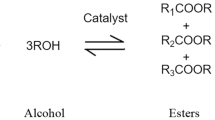Abstract
Realizing the efficiency benefits of low viscosity lubricants requires novel strategies to avoid failures resulting from increased boundary contact. Zirconium dioxide (ZrO2) nanoparticles (NPs) form protective tribofilms through tribosintering at lubricated contacts in pure hydrocarbon base oils, suggesting they hold promise for reducing boundary contact-induced failures. However, their tribological behavior alongside co-additives found in fully formulated oils has not been examined in depth. Here, the macroscopic tribological performance of dispersed ZrO2 NPs (1 wt% loading; 5 nm diameter nearly spherical ZrO2 tetragonal phase NPs with organic capping ligands for oil solubility) with and without the presence of co-additives found in fully formulated commercial gear oils was studied using a mini-traction machine (MTM). The results show that ZrO2 NPs reproducibly develop surface-bound ~ 100 nm thick tribofilms on both contacting surfaces under a wide range of rolling-sliding contact conditions, from 0 to 100% slide-to-roll ratio. Steady-state traction coefficient values of ZrO2 tribofilms formed alongside co-additives (0.10–0.11) do not substantially differ from ZrO2 tribofilms formed in neat polyalphaolefin base oils (0.10–0.13). However, there is improvement in the tribological performance of the contact, with at least a twofold reduction of wear of the steel. This behavior is proposed to be a result of cooperating mechanisms, where the extreme pressure additives adsorbed on the steel surfaces protect them against early adhesive wear, during the time that a protective ZrO2 tribofilm incorporating the co-additives forms on the steel surfaces, preventing further wear.
Graphic Abstract










Similar content being viewed by others
Change history
23 September 2021
A Correction to this paper has been published: https://doi.org/10.1007/s11249-021-01510-1
References
Kakavas, I., Olver, A.V., Dini, D.: Hypoid gear vehicle axle efficiency. Tribol. Int. 101, 314–323 (2016)
Holmberg, K., Andersson, P., Nylund, N.O., Makela, K., Erdemir, A., Global, A.: Global energy consumption due to friction in trucks and buses. Tribol. Int. 78, 94–114 (2014)
International Energy Outlook, Tables A2 and A5. U.S. Energy Information Administration (2019)
Energy Flow Charts: Estimated World Energy Consumption in 2011. Lawrence Livermore National Laboratory (2011)
Stachowiak, G.W., Batchelor, A.W.: Engineering Tribology, 4th edn. Elsevier Inc, Amsterdam (2014)
Rizvi, S.: MNL59-EB A Comprehensive Review of Lubricant Chemistry, Technology, Selection, and Design. ASTM International, West Conshocken, PA (2009). https://doi.org/10.1520/MNL59-EB
Rudnick, L.R.: Lubricant Additives: Chemistry and Applications, 2nd edn. CRC Press Taylor & Francis Group, Boca Raton (2009)
Tuszynski, W., Michalczewski, R., Piekoszewski, W., Szczerek, M.: Modern automotive gear oils - classification, characteristics, market analysis, and some aspects of lubrication. In: Chiaberge, M. (ed.) New Trends and Developments in Automotive Industry. IntechOpen (2011). https://doi.org/10.5772/13014
Johnson, D.W., Hils, J.E.: Phosphate esters, thiophosphate esters and metal thiophosphates as lubricant additives. Lubricants. 1, 132–148 (2013)
Shahnazar, S., Bagheri, S., Hamid, S.B.A.: Enhancing lubricant properties by nanoparticle additives. Int. J. Hydrogen Energy. 41, 3153–3170 (2016)
Dai, W., Kheireddin, B., Gao, H., Liang, H.: Roles of nanoparticles in oil lubrication. Tribol. Int. 102, 88–98 (2016)
Bakunin, V.N., Suslov, A.Y., Kuzmina, G.N., Parenago, O.P., Topchiev, A.V.: Synthesis and application of inorganic nanoparticles as lubricant components—a review. J. Nanopart. Res. 6, 273–284 (2004)
Gulzar, M., Masjuki, H.H., Kalam, M.A., Varman, M., Zulkifli, N.W.M., Mufti, R.A., Zahid, R.: Tribological performance of nanoparticles as lubricating oil additives. J. Nanopart. Res. 18, 223 (2016)
Zhou, S., Garnweitner, G., Niederberger, M., Antonietti, M.: Dispersion behavior of zirconia nanocrystals and their surface functionalization with vinyl group-containing ligands. Langmuir 23, 9178–9187 (2007)
Thrush, S.J., Comfort, A.S., Dusenbury, J.S., Xiong, Y., Qu, H., Han, X., Schall, J.D., Barber, G.C., Wang, X.: Stability, thermal conductivity, viscosity, and tribological characterization of zirconia nanofluids as a function of nanoparticle concentration. Tribol. Trans. 63, 68–76 (2019)
Khare, H.S., Lahouji, I., Jackson, A., Feng, G., Chen, Z., Cooper, G.D., Carpick, R.W.: Nanoscale generation of robust solid films from liquid-dispersed nanoparticles via in situ atomic force microscopy: growth kinetics and nanomechanical properties. ACS Appl. Mater. Interfaces 10, 40335–40347 (2018)
Ma, S., Zheng, S., Cao, D., Guo, H.: Anti-wear and friction performance of ZrO2 nanoparticles as lubricant additive. Particuology. 8, 468–472 (2010)
Battez, A.H., Gonzalez, R., Viesca, J.L., Fernandez, J.E., Fernandez, J.M.D., Machado, A., Chou, R., Riba, J.: CuO, ZrO2 and ZnO nanoparticles as antiwear additive in oil lubricants. Wear 265, 422–428 (2008)
Kato, H., Komai, K.: Tribofilm formation and mild wear by tribo-sintering of nanometer-sized oxide particles on rubbing steel surfaces. Wear 262, 36–41 (2007)
Spikes, H.: The history and mechanisms of ZDDP. Tribol. Lett. 17, 469–489 (2004)
Khare, H.S., Gosvami, N.N., Lahouji, I., Milne, Z.B., McClimon, J.B., Carpick, R.W.: Nanotribological printing: a nanoscale additive manufacturing method. Nano Lett. 18, 6756–6763 (2018)
Acharya, B., Avva, K.S., Thapa, B., Pardue, T.N., Krim, J.: Synergistic effect of nanodiamond and phosphate ester anti-wear additive blends. Lubricants. 6, 56 (2018)
Khajeh, A., Krim, J., Martini, A.: Synergistic effect of nanodiamonds on the adsorption of tricresyl phosphate on iron oxide surfaces. Appl. Phys. Lett. 114, 171602 (2019)
Rensselar, J.V.: Extreme pressure/antiwear additives and friction modifiers. Tribol. Lubr. Technol. 74, 24–28 (2018)
Morina, A., Neville, A., Priest, M., Green, J.H.: ZDDP and MoDTC interactions and their effect on tribological performance—tribofilm characteristics and its evolution. Tribol. Lett. 24, 243 (2006)
de Barros-Bouchet, M.I., Martin, J.M., Le-Mogne, T., Vacher, B.: Boundary lubrication mechanisms of carbon coatings by MoDTC and ZDDP additives. Tribol. Int. 38, 257–264 (2005)
Williams, Z.S.G., Wang, Y., Wiacek, R.J., Bai, X., Gou, L., Thomas, S.I., Xu, W., and Xu, J., Synthesis, capping and dispersion of nanocrystals. WO/2011/133228 (2011).
Williams, Z.S.G., Wang, Y., Wiacek, R.J., Bai, X., Gou, L., Thomas, S.I., Xu, W., and Xu, J., Synthesis, capping and dispersion of nanocrystals. WO/2012/058271 (2012).
Holder, C., Schaak, R.E.: Tutorial on powder X-ray diffraction for characterizing nanoscale materials. ACS Nano 13, 7359–7365 (2019)
Jerman, M., Qiao, Z., Mergel, D.: Refractive index of thin films of SiO2, ZrO2, and HfO2 as a function of the films' mass density. Appl. Opt. 44, 3006–3012 (2005)
Dawczyk, J., Morgan, N., Russo, J., Spikes, H.: Film thickness and friction of ZDDP tribofilms. Tribol. Lett. 67, 34 (2019)
Necas, D., Klapetek, P.: Gwyddion: an open-source software for SPM data analysis. Cent. Eur. J. Phys. 10, 181–188 (2012)
Demas, N.G., Gould, B.J., Greco, A.C., Lorenzo-Martin, C., Erck, R.A., and Ajayi, O.O., Scuffing performance of low-viscosity gear oil containing ZrO2 nanocrystals. Proc. STLE/ASME Int. Jt. Tribol. Conf. (2019)
Dai, W., Kheireddin, B., Gao, H., Kan, Y., Clearfield, A., Liang, H.: Formation of anti-wear tribofilms via alpha-ZrP nanoplatelet as lubricant additives. Lubricants. 4, 1–12 (2016)
Zhang, J., Spikes, H.: On the mechanism of ZDDP antiwear film formation. Tribol. Lett. 63, 24 (2016)
Vadiraj, A., Manivasagam, G., Kamani, K., Sreenivasan, V.S.: Effect of nano oil additive proportions on friction and wear performance of automotive materials. Tribol. in Industry. 34, 3–10 (2012)
Hutchings, I., Shipway, P.: Wear by hard particles. In: Tribology (Second Edition): Friction and Wear of Engineering Materials, pp. 165–236. Butterworth–Heinemann (2017). https://doi.org/10.1016/B978-0-08-100910-9.00006-4
Wang, A., Haskin, L.A., Lane, A.L., Wdowiak, T.J., Squyres, S.W., Wilson, R.J., Hovland, L.E., Manatt, K.S., Raouf, N., Smith, C.D.: Development of the mars microbeam raman spectrometer (MMRS). J. Geophys. Res. 108, 5005 (2003)
Barberis, P., Merle-Mejean, T., Quintard, P.: On Raman spectroscopy of zirconium oxide films. J. Nucl. Mater. 246, 232–242 (1997)
Maczka, M., Lutz, E.T.G., Verbeek, H.J., Oskam, K., Meijerink, A., Hanuza, J., Stuivinga, M.: Spectroscopic studies of dynamically compacted monoclinic ZrO2. J. Phys. Chem. Solid. 60, 1909–1914 (1999)
He, X., Xiao, H., Choi, H., Diaz, A., Mosby, B., Clearfield, A., Liang, H.: Alpha-zirconium phosphate nanoplatelets as lubricant additives. Colloids Surf. A 452, 32–38 (2014)
Johnson, D.W., et al.: Application of Raman spectroscopy to lubricants, lubricated surfaces, and lubrication phenomena. Spectroscopy. 26, 1–4 (2011)
Singh, H., Ramirez, G., Eryilmaz, O., Greco, A., Doll, G., Erdemir, A.: Fatigue resistant carbon coatings for rolling/sliding contacts. Tribol. Int. 98, 172–178 (2016)
Acknowledgements
We gratefully acknowledge support from the U.S. Army Combat Capabilities Development Command Ground Vehicle Systems Center (CCDC GVSC) under Small Business Technology Transfer (STTR) Phase II Award Number DE-SC-0009222. This work was also performed in part at the University of Pennsylvania’s Singh Center for Nanotechnology, an NNCI member supported by NSF Grant ECCS-1542153. Elinski, M. B. acknowledges support from the University of Pennsylvania Provost Postdoctoral Fellowship program. We also thank Pixelligent Technologies, LLC for providing the oil formulations. The authors are appreciative of many useful discussions with N. G. Demas and B. J. Gould at Argonne National Laboratory, S. J. Thrush and A. S. Comfort at the U.S. Army CCDC GVSC, J. Lohuis and S. G. Williams (Pixelligent Technologies, LLC), Z. B. Milne (University of Pennsylvania), and H. S. Khare (formerly at the University of Pennsylvania, now at Gonzaga University).
Funding
U.S. Army Combat Capabilities Development Command Ground Vehicle Systems Center (CCDC GVSC) Small Business Technology Transfer (STTR) Phase II Award Number DE-SC-0009222. University of Pennsylvania’s Singh Center for Nanotechnology, an NNCI member supported by NSF Grant ECCS-1542153. Elinski, M. B. acknowledges support from the University of Pennsylvania Provost Postdoctoral Fellowship program.
Author information
Authors and Affiliations
Corresponding author
Ethics declarations
Conflict of interest
Lei Zheng, Andrew Jackson, Robert J. Wiacek are affiliated with the commercial vendor for the ZrO2 nanoparticles (Pixelligent Technologies, LLC). L. Z. and R. J. W. are employees of Pixelligent and have equity in the company. A. J. is a consultant to Pixelligent. No other coauthors declare competing financial interest.
Additional information
Publisher's Note
Springer Nature remains neutral with regard to jurisdictional claims in published maps and institutional affiliations.
Electronic supplementary material
Below is the link to the electronic supplementary material.
Supplementary file1 (PDF 1652 kb)
Description of Supporting InformationThe Supporting Information has five sections. Section A (Fig. S1) includes additional WLI analysis of MTM-SLIM tests run in 75W-80. Section B (Fig. S2-S3) show traction curves and Stribeck curves for all samples. Section C details the specific film thickness calculations. Section D (Fig. S4-S5) provides supporting tribofilm characterization, including the end-of-test SLIM images and representative characterization with scanning electron microscopy (SEM) and energy dispersive X-ray spectroscopy (EDS). Section E (Fig. S6-S7) discusses the ZrO2 tribofilms formed on the disc specimens corresponding to the ball specimens discussed in Fig. 3 of the main text.
Rights and permissions
About this article
Cite this article
Elinski, M.B., LaMascus, P., Zheng, L. et al. Cooperativity Between Zirconium Dioxide Nanoparticles and Extreme Pressure Additives in Forming Protective Tribofilms: Toward Enabling Low Viscosity Lubricants. Tribol Lett 68, 107 (2020). https://doi.org/10.1007/s11249-020-01346-1
Received:
Accepted:
Published:
DOI: https://doi.org/10.1007/s11249-020-01346-1




